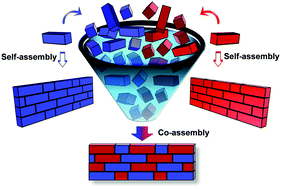当前位置:
X-MOL 学术
›
Chem. Soc. Rev.
›
论文详情
Our official English website, www.x-mol.net, welcomes your feedback! (Note: you will need to create a separate account there.)
Minimalistic peptide supramolecular co-assembly: expanding the conformational space for nanotechnology
Chemical Society Reviews ( IF 46.2 ) Pub Date : 2018-03-02 00:00:00 , DOI: 10.1039/c7cs00827a Pandeeswar Makam 1 , Ehud Gazit
Chemical Society Reviews ( IF 46.2 ) Pub Date : 2018-03-02 00:00:00 , DOI: 10.1039/c7cs00827a Pandeeswar Makam 1 , Ehud Gazit
Affiliation

|
Molecular self-assembly is a ubiquitous process in nature and central to bottom-up nanotechnology. In particular, the organization of peptide building blocks into ordered supramolecular structures has gained much interest due to the unique properties of the products, including biocompatibility, chemical and structural diversity, robustness and ease of large-scale synthesis. In addition, peptides, as short as dipeptides, contain all the molecular information needed to spontaneously form well-ordered structures at both the nano- and the micro-scale. Therefore, peptide supramolecular assembly has been effectively utilized to produce novel materials with tailored properties for various applications in the fields of material science, engineering, medicine, and biology. To further expand the conformational space of peptide assemblies in terms of structural and functional complexity, multicomponent (two or more) peptide supramolecular co-assembly has recently evolved as a promising extended approach, similar to the structural diversity of natural sequence-defined biopolymers (proteins) as well as of synthetic covalent co-polymers. The use of this methodology was recently demonstrated in various applications, such as nanostructure physical dimension control, the creation of non-canonical complex topologies, mechanical strength modulation, the design of light harvesting soft materials, fabrication of electrically conducting devices, induced fluorescence, enzymatic catalysis and tissue engineering. In light of these significant advancements in the field of peptide supramolecular co-assembly in the last few years, in this tutorial review, we provide an updated overview and future prospects of this emerging subject.
中文翻译:

简约肽超分子共组装:扩展纳米技术的构象空间
分子自组装是自然界中普遍存在的过程,也是自下而上的纳米技术的核心。特别是,由于产品的独特性能,包括生物相容性、化学和结构多样性、稳健性和易于大规模合成,将肽构建块组织成有序超分子结构引起了人们的广泛兴趣。此外,肽(如二肽)包含自发形成纳米和微米尺度的有序结构所需的所有分子信息。因此,肽超分子组装已被有效地利用来生产具有定制特性的新型材料,用于材料科学、工程、医学和生物学领域的各种应用。为了在结构和功能复杂性方面进一步扩展肽组装体的构象空间,多组分(两个或更多)肽超分子共组装最近已发展成为一种有前途的扩展方法,类似于天然序列定义的生物聚合物(蛋白质)的结构多样性)以及合成共价共聚物。这种方法的使用最近在各种应用中得到了证明,例如纳米结构物理尺寸控制、非规范复杂拓扑的创建、机械强度调制、光捕获软材料的设计、导电装置的制造、诱导荧光、酶促催化和组织工程。鉴于过去几年肽超分子共组装领域的这些重大进展,在本教程回顾中,我们提供了这一新兴学科的最新概述和未来前景。
更新日期:2018-03-02
中文翻译:

简约肽超分子共组装:扩展纳米技术的构象空间
分子自组装是自然界中普遍存在的过程,也是自下而上的纳米技术的核心。特别是,由于产品的独特性能,包括生物相容性、化学和结构多样性、稳健性和易于大规模合成,将肽构建块组织成有序超分子结构引起了人们的广泛兴趣。此外,肽(如二肽)包含自发形成纳米和微米尺度的有序结构所需的所有分子信息。因此,肽超分子组装已被有效地利用来生产具有定制特性的新型材料,用于材料科学、工程、医学和生物学领域的各种应用。为了在结构和功能复杂性方面进一步扩展肽组装体的构象空间,多组分(两个或更多)肽超分子共组装最近已发展成为一种有前途的扩展方法,类似于天然序列定义的生物聚合物(蛋白质)的结构多样性)以及合成共价共聚物。这种方法的使用最近在各种应用中得到了证明,例如纳米结构物理尺寸控制、非规范复杂拓扑的创建、机械强度调制、光捕获软材料的设计、导电装置的制造、诱导荧光、酶促催化和组织工程。鉴于过去几年肽超分子共组装领域的这些重大进展,在本教程回顾中,我们提供了这一新兴学科的最新概述和未来前景。

























 京公网安备 11010802027423号
京公网安备 11010802027423号